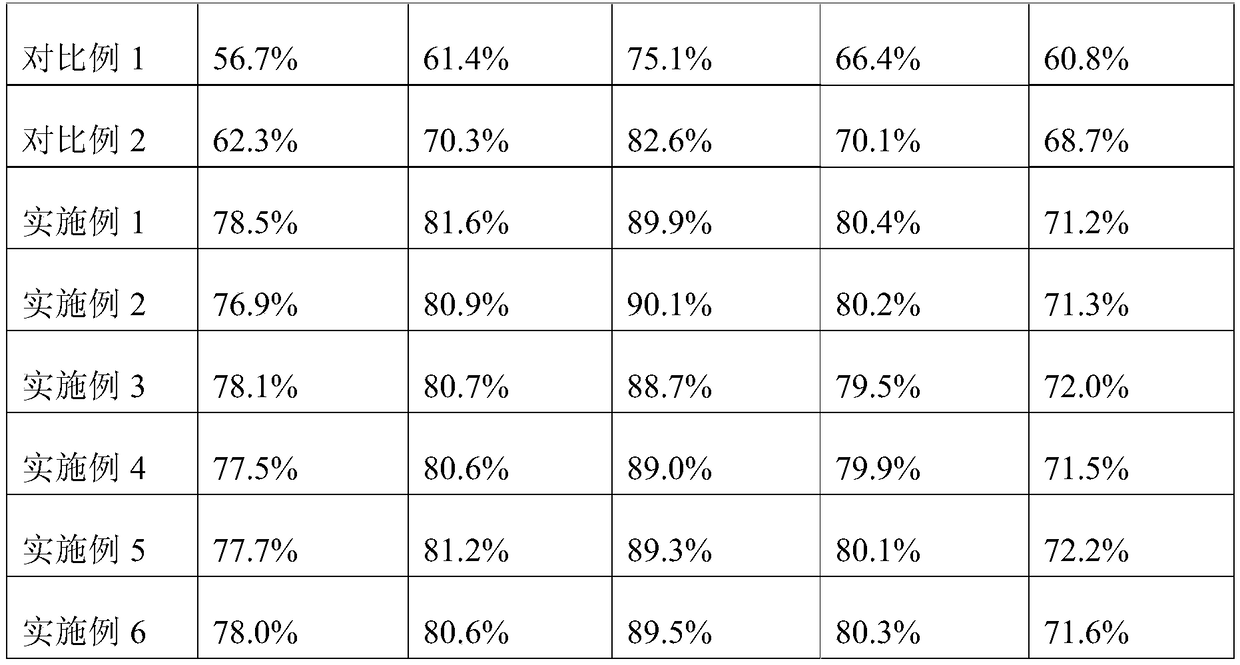Ecological fermented cow feed taking pennisetum purpureum schumab cv.purple and lobular horse tamarind as substrate
A technology of fermented feed and Leucaena, applied in animal feed, animal feed, chlorella, etc., can solve the problems of negative effects and affecting the absorption of nutrients for cattle to eat, so as to promote fermentation, break seasonal utilization restrictions, and enrich feed sources Effect
- Summary
- Abstract
- Description
- Claims
- Application Information
AI Technical Summary
Problems solved by technology
Method used
Image
Examples
Embodiment 1
[0026] A method for preparing cattle ecological fermented feed with purple elephant grass and Leucaena microphylla as substrates, comprising the following steps:
[0027] (1) Pretreatment of Leucaena microphylla: in parts by weight, chop 100 parts of tender stems and leaves of Leucaena microphylla into 1cm segments, put them into warm water at 35°C for 12min, and quickly remove them at -20°C after taking them out. Freeze in the environment for 24 hours, put it into the fermentation container after thawing, control the stacking thickness of Leucaena lobata to 4cm, mix 3 parts of extracellular enzymes, and then pass through N 2 and C0 2 The volume ratio is 1:20 N 2 / C0 2 The mixed gas was carried out for the first fermentation at 23°C for 20 hours to obtain the pretreated Leucaena lobata;
[0028] (2) drying of purple elephant grass: the purple elephant grass is air-dried to a moisture content of 68%, then cut into 1cm segments for subsequent use;
[0029] (3) Secondary ferm...
Embodiment 2
[0031] A method for preparing cattle ecological fermented feed with purple elephant grass and Leucaena microphylla as substrates, comprising the following steps:
[0032] (1) Pretreatment of Leucaena microphylla: in parts by weight, chop 100 parts of tender stems and leaves of Leucaena microphylla into 1.3cm segments, put them into warm water at 37°C for 15 minutes, and take them out quickly at -20°C Freeze in an environment for 26 hours, put it into a fermentation container after thawing, control the stacking thickness of Leucaena lobata to 4.5cm, mix 4 parts of extracellular enzymes, and then pass through N 2 and C0 2 The volume ratio is 1:22 N 2 / C0 2 The mixed gas was carried out for the first fermentation at 26°C for 25 hours to obtain the pretreated Leucaena lobata;
[0033] (2) drying of purple elephant grass: the purple elephant grass is air-dried to a moisture content of 69%, then cut into 1.5cm segments for subsequent use;
[0034](3) Secondary fermentation: in p...
Embodiment 3
[0036] A method for preparing cattle ecological fermented feed with purple elephant grass and Leucaena microphylla as substrates, comprising the following steps:
[0037] (1) Pretreatment of Leucaena microphylla: in parts by weight, chop 100 parts of tender stems and leaves of Leucaena microphylla into 1.5cm segments, put them into warm water at 40°C for 17min, and take them out quickly at -20°C Freeze in an environment for 30 hours, put it into a fermentation container after thawing, control the stacking thickness of Leucaena lobata to 5cm, mix 4 parts of extracellular enzymes, and then pass through N 2 and C0 2 The volume ratio is 1:27 N 2 / C0 2 The mixed gas was carried out for the first fermentation at 26°C for 28 hours to obtain the pretreated Leucaena lobata;
[0038] (2) drying of purple elephant grass: the purple elephant grass is air-dried to a moisture content of 70%, then cut into 1.4cm segments for subsequent use;
[0039] (3) Secondary fermentation: in parts b...
PUM
 Login to View More
Login to View More Abstract
Description
Claims
Application Information
 Login to View More
Login to View More - R&D
- Intellectual Property
- Life Sciences
- Materials
- Tech Scout
- Unparalleled Data Quality
- Higher Quality Content
- 60% Fewer Hallucinations
Browse by: Latest US Patents, China's latest patents, Technical Efficacy Thesaurus, Application Domain, Technology Topic, Popular Technical Reports.
© 2025 PatSnap. All rights reserved.Legal|Privacy policy|Modern Slavery Act Transparency Statement|Sitemap|About US| Contact US: help@patsnap.com


